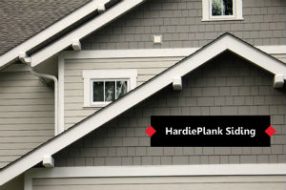THE BLOG

13 Frequently Asked Questions About HardiePlank Siding
HardiePlank siding, a specific type of fiber-cement siding, has quickly become one of the most popular forms of siding in the United States, and for good reason. It’s one of the best, most durable forms of siding available, and it puts old-school vinyl siding (and most other types of siding) to shame in terms of longevity and overall value.
Still, fiber-cement siding is a new concept for most homeowners, and there are a lot of misconceptions and ambiguities about what exactly HardiePlank siding is. In response to ballooning customer interest and curiosity about the specifics, we’ve put together this handy “FAQ” resource to answer some of your most common questions and concerns.
Frequently Asked Questions
These are some of the most common questions we hear:
1. What is fiber-cement, anyway? Fiber-cement refers to the composite mixture that this type of siding features. Rather than using one type of material, like vinyl, wood, or brick, fiber-cement is a melding of several different interrelated materials, including cement, ground sand, cellulose fiber, water, and a selection of minor additives to bring everything together. This mixture of materials has been perfected in terms of durability and longevity, making it one of the strongest forms of siding available on the market.
2. What is HardiePlank then? HardiePlank siding is a specific brand of fiber-cement siding. It’s sometimes known as James Hardie siding, and comes in a variety of different sub-products. While there are a handful of other suppliers of fiber-cement siding, HardiePlank has been in existence the longest, and is known as the leader in the industry.
3. How much does fiber-cement siding cost? The price of fiber-cement siding can vary wildly depending on a number of factors, including where you live, what type of house you have, what brand of siding you choose to go with, and of course, what contractor you choose to work with. You can expect a minimum cost of at least a few thousand dollars, with the majority of jobs falling somewhere between $10,000 and $20,000; but again, this depends on a number of external factors.
4. Why does it cost so much more than vinyl siding? Fiber-cement siding is more expensive because it uses stronger materials and takes more time to produce, just as a dinner at a nice restaurant generally costs more than a fast food meal. Vinyl became popular due to its extraordinary ease of production and installation, but fiber-cement is a different level of quality.
5. Is it worth the extra money? Though we’re a bit biased, the answer is an objective “yes.” It’s more durable, it requires less maintenance, it protects your home better, and increases your home value more. All in all, it’s a better investment worth every dollar of additional cost.
6. How long does it last? Fiber-cement siding is known for its longevity, so you can count on a new installation lasting for decades. HardiePlank siding offers a 30-year warranty on all its products, though you can reasonably expect siding to last far longer under normal conditions.
7. How is it installed? HardiePlank siding comes in long planks that can be cut and fit to your home’s exterior. One of its greatest advantages is its ease of installation; with an experienced crew, most homes will only take a few business days for a complete installation.
8. Does it need to be painted or maintained? Once installed, your siding will need to be painted. However, using the proper paint, it’s unlikely that your siding will ever need painted or maintained again. HardiePlank siding doesn’t wear the way that vinyl siding does, and requires almost zero upkeep.
9. How fire resistant is it? HardiePlank siding is especially resistant to fire compared to most other types of siding. It will not catch fire, and will not contribute fuel to an existing fire. It does transfer heat, however, much in the way that a pan on the stove gets hot but never catches fire. It is comparable to brick and stone.
10. How mold resistant is it? HardiePlank siding is completely sealed to keep out moisture, and features moldicide to prevent mold from growing or spreading. Occasionally, dirt and the elements may produce conditions for mold to appear on your home’s exterior, but this can easily be sprayed away with a garden hose.
11. Is it resistant to the elements? Fiber-cement siding is quite resistant to weather and insect damage. No termites or wood-eating insects can bore through the siding, and it protects your house sufficiently against rain, snow, hail, high winds, and other forms of environmental damage. Its performance and durability don’t degrade over time, so you can count on this protection indefinitely.
12. Does it carry any environmental concerns or consequences? There are practically no environmental concerns when it comes to purchasing and installing HardiePlank siding. There are no components of asbestos, glass fibers, or formaldehyde in this type of siding, differentiating it from other questionable types of siding like vinyl. Fiber-cement siding is one of the most environmentally responsible choices you can make for the exterior of your home.
13. Where can I buy it? There are a number of accredited suppliers of HardiePlank siding, most of whom are siding contractors who can also do the work of installing the siding on your home. K & B Home Remodelers are one such contractor. If you’re interesting in learning more about our certifications or about what types of James Hardie siding we offer, check out our dedicated information page or contact us.
After seeing and understanding these questions, you should have a good idea about whether or not HardiePlank siding is the right choice for your home. If you still have questions, or if you’re ready to get more information specific to your home, request a quote from us today. There’s no obligation and no pressure—we’ll give you all the information you need to make the best decision for you and your home.
